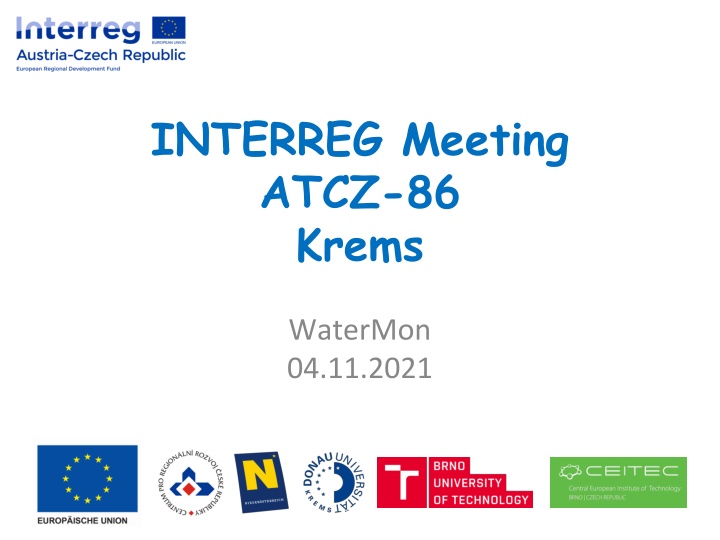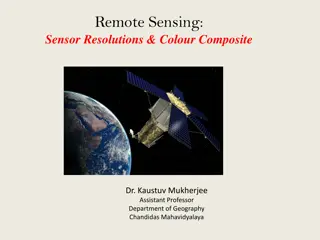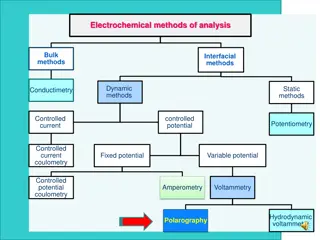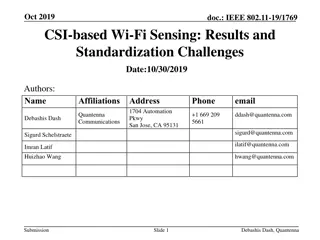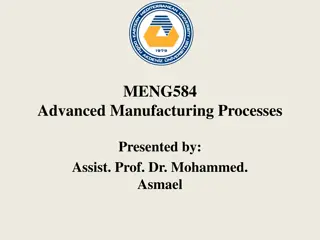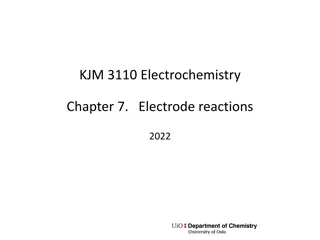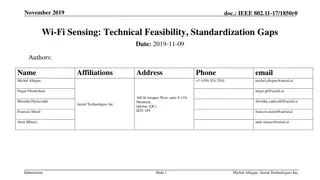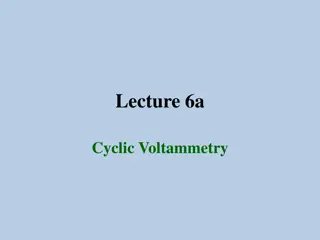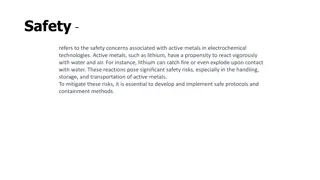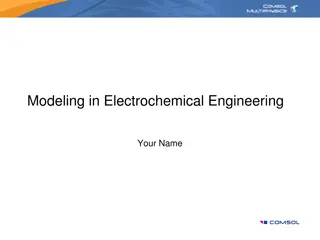Electrochemical Sensing Module Overview and Potentiostat Parameters
In this meeting, the Electrochemical Sensing Module based on the EmStat-pico potentiostat was discussed. The module features precise, low-power control unit Arduino MKR Zero and supports techniques such as voltammetry and EIS. Potentiostat parameters include a full dc-potential range, EIS frequency range, and various current ranges and modes. The module's voltammetric techniques encompass Linear Sweep Voltammetry, Cyclic Voltammetry, and more. Additionally, limitations of the potentiostat, including precision resistors for self-calibration, were highlighted.
Uploaded on Sep 25, 2024 | 1 Views
Download Presentation

Please find below an Image/Link to download the presentation.
The content on the website is provided AS IS for your information and personal use only. It may not be sold, licensed, or shared on other websites without obtaining consent from the author.If you encounter any issues during the download, it is possible that the publisher has removed the file from their server.
You are allowed to download the files provided on this website for personal or commercial use, subject to the condition that they are used lawfully. All files are the property of their respective owners.
The content on the website is provided AS IS for your information and personal use only. It may not be sold, licensed, or shared on other websites without obtaining consent from the author.
E N D
Presentation Transcript
INTERREG Meeting ATCZ-86 Krems WaterMon 04.11.2021
Electrochemical sensing module Jakub Arm 2 04.11.2021
Agenda Overview of the sensing module Potentiostat parameters Potentiostat example of LSV Sensing module power consumption Future plans 3 04.11.2021
Overview The module is based on EmStat-pico (potentiostat) Precise, low-power device Control unit Arduino MKR Zero Programing (measurement) using scripts (tuneable) Supported techniques: voltammetry, EIS Electrodes - printed Preliminary study was promising with both the SPGE and SPCE (half yearly progress report) Communication with the control unit via UART 3,3 V (RXD, TXD, GND) defined on the last telco 4 04.11.2021
Potentiostat parameters Full dc-potential range: -1.7 (-1.2) V to +2 V EIS frequency range: 0.016 Hz to 200 kHz Current ranges: 100 nA to 5 mA Modes: Low Speed (up to 1 V/s or up to 100 Hz) High Speed (up to 200 kHz) Max Range (optimal dynamic dc-potential range) Source: https://www.palmsens.com/product/oem-emstat-pico-module/ 5 04.11.2021
Potentiostat parameters Voltammetric techniques: Linear Sweep Voltammetry Cyclic Voltammetry Square Wave Voltammetry Differential Pulse Voltammetry Normal Pulse Voltammetry Electrochemical Impedance Spectroscopy Techniques as a function of time: Chronoamperometry Pulsed Amperometric Detection Open Circuit Potentiometry MultiStep Amperometry 6 04.11.2021
Potentiostat parameters 7 04.11.2021
Potentiostat parameters 8 04.11.2021
Potentiostat limitations On-board 1 k and 100 k precision resistors (accuracy: 0.1%, temperature coefficient: 25 ppm/ C) for self- calibration 9 04.11.2021
Potentiostat LSV example The whole measurement takes approx. 10s 10 04.11.2021
Power consumption - theoretical EmStat Pico (Normal, High Speed, 1 channel): 30 mA @ 5 VDC EmStat Pico (Normal, Low Speed, 1 channel): 10 mA @ 5 VDC EmStat Pico (Hibernate): 10 uA @ 5 VDC Arduino MKR Zero (maximum rating): 600 mA @ 5 VDC 11 04.11.2021
Power consumption - measured EmStat Pico (Normal, 1 channel) + Arduino MKR Zero: 40 - 70 mA @ 5 VDC (Linear Sweep Voltammetry) Arduino MKR Zero: 20 mA @ 5 VDC (only CPU and UART) 12 04.11.2021
Power consumption - estimated Measuring mode 80 mA @ 5 VDC for approx. 10 s (depends on the measurement script) Sleep mode: 30 uA @ 5 VDC for approx. 15 min (depends on the scenario) Calculated consumption: 0,92 mAh @ 5 VDC 13 04.11.2021
Future plans Study with the E.coli culture to induce the growth of enzyme by the bacteria itself and obtain the 8-HQ (electroactive species) to be detected electrochemically (half yearly progress report) Calibration of the E.coli conc. detection to attain the LOD (half yearly progress report) 14 04.11.2021
Future plans Implement communication protocol (waiting for the description) Design and implement business logic of the sensing module Design and implement the measurement scripts (will be defined by MENDELU) Debugging (connection with potentiostat, script handling) Reduce power consumption if needed 15 04.11.2021
Thank you for the Attention Questions ?
